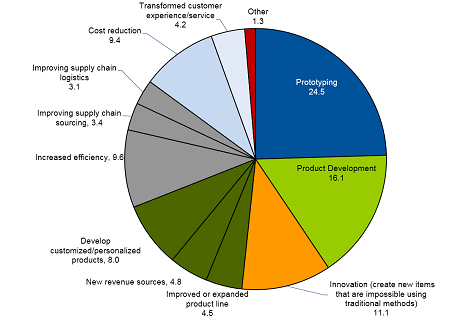Sixty percent of organizations said high start-up costs are a main factor in the delay of implementing 3D printing strategies, according to a new survey by Gartner, Inc. However, the survey also found that early adopters of the technology are finding clear benefits in multiple areas.
In the second quarter of 2014, Gartner conducted a worldwide survey to determine how organizations are using or planning to use 3D printing technologies. Survey participants were 330 individuals employed by organizations with at least 100 employees that are using or planning to use 3D printing.
“3D printing has broad appeal to a wide range of businesses and early adopter consumers, and while the technology is already in use across a wide range of manufacturing verticals from medical to aerospace, costs remain the primary concern for buyers,” said Pete Basiliere, research director at Gartner. “3D printer vendors must work closely with their clients to identify potential applications of the technology that may have been overlooked, and improve the cost-benefit ratios of their products. Organizations that wish to experiment with the technology without incurring start-up costs should consider partnering with a local 3D printing service bureau.”
The survey also revealed that while prototyping, product innovation and development are the main uses of 3D printing, the technology is also being used extensively in manufacturing applications.
“The market is emerging from its nascent stage as organizations move beyond design and prototyping applications of 3D printing toward creating short run production quantities of finished products,” said Mr. Basiliere. “Based on these results and the answers to other survey questions, we predict that by 2018, almost 50 percent of consumer, heavy industry and life sciences manufacturers will use 3D printing to produce parts for the items they consume, sell or service.”
Despite this ongoing evolution, 53 percent of survey respondents indicated that managers of R&D engineering or manufacturing are the primary influencer driving any 3D printing strategy. The CIO, CTO and others outside of operations groups do play a role, but are not the primary decision makers.
“An interesting finding was that respondents felt overwhelmingly that using a 3D printer as part of their supply chain generally reduces the cost of existing processes, especially research and product development costs,” said Mr. Basiliere. “The mean cost reduction for finished goods is between 4.1 percent and 4.3 percent, which is an impressive figure. It shows that early adopters of the technology are finding clear benefits, which are likely to drive further adoption.”

